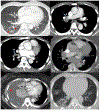High prevalence of pulmonary findings in computed tomographies of HTLV-1-infected patients with and without adult-T cell leukemia/lymphoma - implications for staging
- PMID: 31204876
- PMCID: PMC7473494
- DOI: 10.1080/10428194.2019.1627543
High prevalence of pulmonary findings in computed tomographies of HTLV-1-infected patients with and without adult-T cell leukemia/lymphoma - implications for staging
Abstract
Lung involvement has been reported in HTLV-1 carriers and in patients with ATLL. Whether there are differences in the pattern of lung involvement between ATLL and HTLV carriers in North American patients is unknown. We aimed to compare CT pulmonary findings among patients with HTLV-1 infection with and without ATLL. Among 140 patients with HTLV-1 diagnosis, 97 had CT chest available. Of these, 72 (74.2%) had ATLL and 25 (25.8%) did not have ATLL. CT chest abnormalities were present in 90 (92.8%) participants (94.4% in ATLL; 88% in non-ATLL). Higher rates of lymphadenopathy (69.4% versus 24%, p < .01) and lower rates of bronchiectasis (25% versus 48%, p = .04) were seen in ATLL compared to non-ATLL. Our study supports that staging of lung involvement in ATLL should consider HTLV-associated pulmonary findings as not all CT chest abnormalities necessarily represent malignant infiltration.
Keywords: ATLL; HTLV-1; T-cell lymphoma.
Figures

Similar articles
-
Centrilobular nodules are predictive chest computed tomography (CT) findings related to adult T-cell leukemia/lymphoma development in human T-lymphotropic virus type I carriers.Clin Radiol. 2025 Feb;81:106765. doi: 10.1016/j.crad.2024.106765. Epub 2024 Dec 4. Clin Radiol. 2025. PMID: 39733476
-
Genetic profile of adult T-cell leukemia/lymphoma in Okinawa: Association with prognosis, ethnicity, and HTLV-1 strains.Cancer Sci. 2021 Mar;112(3):1300-1309. doi: 10.1111/cas.14806. Epub 2021 Jan 31. Cancer Sci. 2021. PMID: 33426772 Free PMC article.
-
Adult T-cell leukemia/lymphoma in Jujuy, north-west Argentina.Pathol Int. 2002 May-Jun;52(5-6):348-57. doi: 10.1046/j.1440-1827.2002.01356.x. Pathol Int. 2002. PMID: 12100517
-
Adult T cell leukemia/lymphoma: FoxP3(+) cells and the cell-mediated immune response to HTLV-1.Adv Cancer Res. 2011;111:163-82. doi: 10.1016/B978-0-12-385524-4.00004-0. Adv Cancer Res. 2011. PMID: 21704832 Review.
-
NF-κB signaling mechanisms in HTLV-1-induced adult T-cell leukemia/lymphoma.FEBS J. 2018 Sep;285(18):3324-3336. doi: 10.1111/febs.14492. Epub 2018 May 14. FEBS J. 2018. PMID: 29722927 Free PMC article. Review.
Cited by
-
Human T-cell leukaemia virus type 1 associated pulmonary disease: clinical and pathological features of an under-recognised complication of HTLV-1 infection.Retrovirology. 2021 Jan 6;18(1):1. doi: 10.1186/s12977-020-00543-z. Retrovirology. 2021. PMID: 33407607 Free PMC article. Review.
References
-
- Ita F, Mayer EF, Verdonck K, Gonzalez E, Clark D, Gotuzzo E. Human T-lymphotropic virus type 1 infection is frequent in rural communities of the southern Andes of Peru. Int J Infect Dis. 2014;19:46–52. - PubMed
-
- Phillips AA, Harewood JCK. Adult T Cell Leukemia-Lymphoma (ATL): State of the Art. Curr Hematol Malig Rep. 2018;13(4):300–7. - PubMed
Publication types
MeSH terms
Grants and funding
LinkOut - more resources
Full Text Sources
Medical
